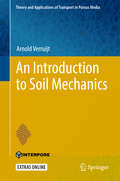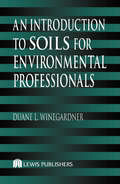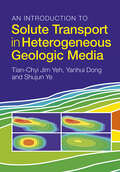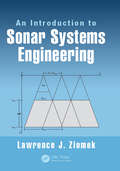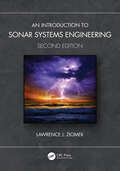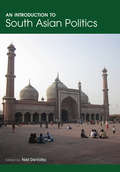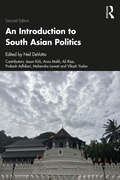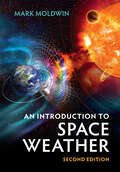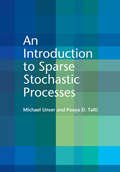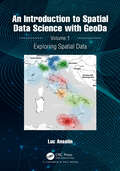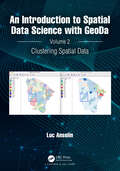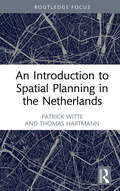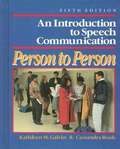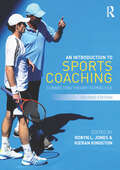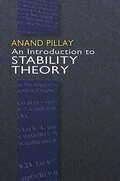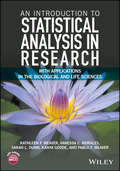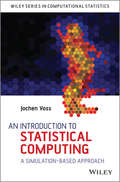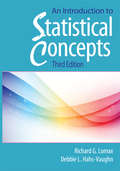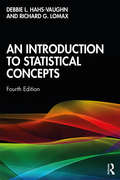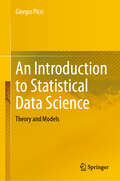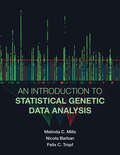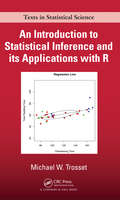- Table View
- List View
An Introduction to Soil Mechanics (Theory and Applications of Transport in Porous Media #30)
by Arnold VerruijtThis textbook offers a superb introduction to theoretical and practical soil mechanics. Special attention is given to the risks of failure in civil engineering, and themes covered include stresses in soils, groundwater flow, consolidation, testing of soils, and stability of slopes. Readers will learn the major principles and methods of soil mechanics, and the most important methods of determining soil parameters both in the laboratory and in situ. The basic principles of applied mechanics, that are frequently used, are offered in the appendices. The author's considerable experience of teaching soil mechanics is evident in the many features of the book: it is packed with supportive color illustrations, helpful examples and references. Exercises with answers enable students to self-test their understanding and encourage them to explore further through additional online material. Numerous simple computer programs are provided online as Electronic Supplementary Material. As a soil mechanics textbook, this volume is ideally suited to supporting undergraduate civil engineering students.
An Introduction to Soils for Environmental Professionals
by Duane L. WinegardnerAn Introduction to Soils for Environmental Professionals assembles and presents the basic principles of each of the major soil science fields. It introduces fundamental concepts and shows the interrelationships between the various branches of soil science - from mineralogy to soil physics.
An Introduction to Solute Transport in Heterogeneous Geologic Media
by Tian-Chyi Jim Yeh Yanhui Dong Shujun YeOver the past several decades, analyses of solute migration in aquifers have widely adopted the classical advection-dispersion equation. However, misunderstandings over advection-dispersion concepts, their relationship with the scales of heterogeneity, our observation and interest, and their ensemble mean nature have created furious debates about the concepts' validity. This book provides a unified and comprehensive overview and lucid explanations of the stochastic nature of solute transport processes at different scales. It also presents tools for analyzing solute transport and its uncertainty to meet our needs at different scales. Easy-to-understand physical explanations without complex mathematics make this book an invaluable resource for students, researchers, and professionals performing groundwater quality evaluations, management, and remediation.
An Introduction to Sonar Systems Engineering
by Lawrence J. ZiomekWritten in tutorial style, this textbook discusses the fundamental topics of modern day Sonar Systems Engineering for the analysis and design of both active and passive sonar systems. Included are basic signal design for active sonar systems and understanding underwater acoustic communication signals. Mathematical theory is provided, plus practical design and analysis equations for both passive and active sonar systems. Practical homework problems are included at the end of each chapter and a solutions manual and lecture slides for each chapter are available for adopting professors.
An Introduction to Sonar Systems Engineering
by Lawrence J. ZiomekAn Introduction to Sonar Systems Engineering Second Edition Important topics that are fundamental to the understanding of modern-day sonar systems engineering are featured. Linear, planar, and volume array theory, including near-field and far-field beam patterns, beam steering, and array focusing, are covered. Real-world arrays such as the twin-line planar array and a linear array of triplets, which are solutions to the port/starboard (left/right) ambiguity problem associated with linear towed arrays, are examined in detail. Detailed explanations of the fundamentals of side-looking (side-scan) and synthetic-aperture sonars are presented. Bistatic scattering with moving platforms is explored with derivations of exact solutions for the time delay, time-compression/time-expansion factor, and Doppler shift at a receiver for both the scattered and direct acoustic paths. Time-domain and frequency-domain descriptions, and the design of CW, LFM, and Doppler-invariant HFM pulses, are explained. Target detection in the presence of reverberation and noise is examined. Time-domain and frequency-domain descriptions of MFSK, MQAM, and OFDM underwater acoustic communication signals are also discussed. Although the book is mathematically rigorous, it is written in a tutorial style. Many useful, practical design and analysis equations for both passive and active sonar systems are derived from first principles. No major steps in the derivation of important results are skipped – all assumptions and approximations are clearly stated. Particular attention is paid to the correct units for functions and parameters. Many figures, tables, examples, and practical homework problems at the end of each chapter are included to aid in the understanding of the material covered. New to the Second Edition Chapter 15 Synthetic-Aperture Sonar Chapter 13, Section 13.3, The Rectangular-Envelope HFM Pulse Chapter 10, Section 10.7, Moving Platforms, was rewritten, which allowed for the elimination of Appendix 10C from the first edition New explanations/discussions were added to Subsections 1.2.1 and 1.3.1 in Chapter 1 Appendix 1A was rewritten and the new Table 1A-1 was added to Chapter 1 A solutions manual is available for adopting professors
An Introduction to South Asia (Routledge Revivals)
by B.H. FarmerOriginally published in 1983 and here reissuing the second edition of 1993, An Introduction to South Asia presents the geographical and historical background to the diversities of the region. From the legacy of the colonial period and the controversies that surrounded partition and independence, the book traces the consequences of social divisions, particularly of religion, caste and language, into contemporary politics. Interwoven issues on environments, sociology, politics, and economies combine to explain development patterns and problems, the processes behind them, and the reciprocal impact of South Asia and the wider world.This fully updated second edition provides new material on environmental issues, the causes and consequences of natural disasters, and the role of women in the region. It provides a comprehensive, interdisciplinary guide to the varying environments—natural, social, political, and economic—that characterize South Asia.
An Introduction to South Asian Politics
by Neil DeVottaThis introductory textbook provides students with a fundamental understanding of the social, political, and economic institutions of six South Asian countries: Afghanistan, Bangladesh, India, Nepal, Pakistan, and Sri Lanka. It adopts a broad theoretical framework and evaluates the opportunities and constraints facing South Asia’s states within the context of democracy. Key features include: An introduction to the region. The history and political development of these South Asian states, including evaluations of their democratic trajectories. The management of conflict, economic development, and extremist threats. A comparative analysis of the states. Projections concerning democracy taking into consideration the opportunities and constraints facing these countries. This textbook will be an indispensable teaching tool for courses on South Asia. It includes pedagogical features such as political chronologies, political party descriptions, text boxes, a glossary, and suggestions for further reading. Written in an accessible style and by experts on South Asian politics, it offers students of South Asian politics a valuable introduction to an exceedingly diverse region.
An Introduction to South Asian Politics
by Neil DeVottaThe second edition of this introductory textbook provides students with an overarching understanding of social, political, and economic institutions of six South Asian countries: Afghanistan, Bangladesh, India, Nepal, Pakistan, and Sri Lanka. Using democracy as a prism, it evaluates the varied opportunities and constraints facing these states.Key features include: Introduction to the region The history and development of these South Asian states, including evaluations of their democratic trajectories The management of conflict, economic development, and extremist threats A comparative analysis of the states Projections concerning democracy given evolving challenges The textbook is an indispensable teaching tool for courses on South Asia. It includes pedagogical features such as political chronologies, political party descriptions, text boxes, a glossary, and suggestions for further reading. It is written in an accessible style by country experts, thus offering students of South Asian politics a valuable introduction to an exceedingly diverse and complicated region.
An Introduction to Space Plasma Complexity
by Tom Tien Sun ChangAn Introduction to Space Plasma Complexity considers select examples of complexity phenomena related to observed plasma processes in the space environment, such as those pertaining to the solar corona, the interplanetary medium, and Earth's magnetosphere and ionosphere. This book provides a guided tour of the ideas behind forced and/or self-organized criticality, intermittency, multifractals, and the theory of the dynamic renormalization group, with applications to space plasma complexity. There is much to be explored and studied in this relatively new and developing field. Readers will be able to apply the concepts and methodologies espoused in this introduction to their own research interests and activities.
An Introduction to Space Weather
by Mark MoldwinOur space age technology enables global communication, navigation, and power distribution that has given rise to our 'smart', interconnected and spacefaring world. Much of the infrastructure modern society depends on, to live on Earth and to explore space, is susceptible to space weather storms originating from the Sun. The Second Edition of this introductory textbook is expanded to reflect our increased understanding from more than a dozen scientific missions over the past decade. Updates include discussions of the rapidly expanding commercial space sector, orbital debris and collision hazards, our understanding of solar-terrestrial connections to climate, and the renewed emphasis of human exploration of the Moon and Mars. It provides new learning features to help students understand the science and solve meaningful problems, including some based on real-world data. Each chapter includes learning objectives and supplements that provide descriptions of the science and learning strategies to help students and instructors alike.
An Introduction to Sparse Stochastic Processes
by Michael Unser Pouya D. TaftiProviding a novel approach to sparse stochastic processes, this comprehensive book presents the theory of stochastic processes that are ruled by stochastic differential equations, and that admit a parsimonious representation in a matched wavelet-like basis. Two key themes are the statistical property of infinite divisibility, which leads to two distinct types of behaviour - Gaussian and sparse - and the structural link between linear stochastic processes and spline functions, which is exploited to simplify the mathematical analysis. The core of the book is devoted to investigating sparse processes, including a complete description of their transform-domain statistics. The final part develops practical signal-processing algorithms that are based on these models, with special emphasis on biomedical image reconstruction. This is an ideal reference for graduate students and researchers with an interest in signal/image processing, compressed sensing, approximation theory, machine learning, or statistics.
An Introduction to Spatial Data Science with GeoDa: Volume 1: Exploring Spatial Data
by Luc AnselinThis book is the first in a two-volume series that introduces the field of spatial data science. It offers an accessible overview of the methodology of exploratory spatial data analysis. It also constitutes the definitive user’s guide for the widely adopted GeoDa open-source software for spatial analysis. Leveraging a large number of real-world empirical illustrations, readers will gain an understanding of the main concepts and techniques, using dynamic graphics for thematic mapping, statistical graphing, and, most centrally, the analysis of spatial autocorrelation. Key to this analysis is the concept of local indicators of spatial association, pioneered by the author and recently extended to the analysis of multivariate data.The focus of the book is on intuitive methods to discover interesting patterns in spatial data. It offers a progression from basic data manipulation through description and exploration to the identification of clusters and outliers by means of local spatial autocorrelation analysis. A distinctive approach is to spatialize intrinsically non-spatial methods by means of linking and brushing with a range of map representations, including several that are unique to the GeoDa software. The book also represents the most in-depth treatment of local spatial autocorrelation and its visualization and interpretation by means of GeoDa.The book is intended for readers interested in going beyond simple mapping of geographical data to gain insight into interesting patterns. Some basic familiarity with statistical concepts is assumed, but no previous knowledge of GIS or mapping is required.Key Features:• Includes spatial perspectives on cluster analysis• Focuses on exploring spatial data• Supplemented by extensive support with sample data sets and examples on the GeoDaCenter websiteThis book is both useful as a reference for the software and as a text for students and researchers of spatial data science.Luc Anselin is the Founding Director of the Center for Spatial Data Science at the University of Chicago, where he is also the Stein-Freiler Distinguished Service Professor of Sociology and the College, as well as a member of the Committee on Data Science. He is the creator of the GeoDa software and an active contributor to the PySAL Python open-source software library for spatial analysis. He has written widely on topics dealing with the methodology of spatial data analysis, including his classic 1988 text on Spatial Econometrics. His work has been recognized by many awards, such as his election to the U.S. National Academy of Science and the American Academy of Arts and Science.
An Introduction to Spatial Data Science with GeoDa: Volume 2: Clustering Spatial Data
by Luc AnselinThis book is the second in a two-volume series that introduces the field of spatial data science. It moves beyond pure data exploration to the organization of observations into meaningful groups, i.e., spatial clustering. This constitutes an important component of so-called unsupervised learning, a major aspect of modern machine learning.The distinctive aspects of the book are both to explore ways to spatialize classic clustering methods through linked maps and graphs, as well as the explicit introduction of spatial contiguity constraints into clustering algorithms. Leveraging a large number of real-world empirical illustrations, readers will gain an understanding of the main concepts and techniques and their relative advantages and disadvantages. The book also constitutes the definitive user’s guide for these methods as implemented in the GeoDa open source software for spatial analysis.It is organized into three major parts, dealing with dimension reduction (principal components, multidimensional scaling, stochastic network embedding), classic clustering methods (hierarchical clustering, k-means, k-medians, k-medoids and spectral clustering), and spatially constrained clustering methods (both hierarchical and partitioning). It closes with an assessment of spatial and non-spatial cluster properties.The book is intended for readers interested in going beyond simple mapping of geographical data to gain insight into interesting patterns as expressed in spatial clusters of observations. Familiarity with the material in Volume 1 is assumed, especially the analysis of local spatial autocorrelation and the full range of visualization methods.Luc Anselin is the Founding Director of the Center for Spatial Data Science at the University of Chicago, where he is also Stein-Freiler Distinguished Service Professor of Sociology and the College, as well as a member of the Committee on Data Science. He is the creator of the GeoDa software and an active contributor to the PySAL Python open-source software library for spatial analysis. He has written widely on topics dealing with the methodology of spatial data analysis, including his classic 1988 text on Spatial Econometrics. His work has been recognized by many awards, such as his election to the U.S. National Academy of Science and the American Academy of Arts and Science.
An Introduction to Spatial Planning in the Netherlands
by Thomas Hartmann Patrick WitteThis book provides an introduction to spatial planning in the Netherlands. It explores the academic underpinnings of the discipline and its practical implications, making use of insights on planning practices from the Netherlands. As an academic book with relevance for spatial planning teaching and practice, the relation between planning practice and planning as an academic discipline are discussed. A key analytical concept is introduced to discuss the different dimensions of planning: the planning triangle. This framework helps to bridging the strategic and conceptual elements of planning with its realization. The object, process and context of planning and its relations are discussed. The core of the academic discipline and profession of spatial planning entails looking (far) into the future, stimulating discussion, formulating a desired future direction through an informal and collective planning process and then formalizing and placing current action into that future perspective. In that sense, spatial planning can be understood as the strategic organisation of hopes and expectations. As a study book it is suitable for students of planning at various universities, but also for students in higher professional education. For those involved in the professional field of spatial planning, this book offers a sound foundation.
An Introduction to Special Functions (UNITEXT #102)
by Carlo ViolaThe subjects treated in this book have been especially chosen to represent a bridge connecting the content of a first course on the elementary theory of analytic functions with a rigorous treatment of some of the most important special functions: the Euler gamma function, the Gauss hypergeometric function, and the Kummer confluent hypergeometric function. Such special functions are indispensable tools in "higher calculus" and are frequently encountered in almost all branches of pure and applied mathematics. The only knowledge assumed on the part of the reader is an understanding of basic concepts to the level of an elementary course covering the residue theorem, Cauchy's integral formula, the Taylor and Laurent series expansions, poles and essential singularities, branch points, etc. The book addresses the needs of advanced undergraduate and graduate students in mathematics or physics.
An Introduction to Speech Communication: Person to Person (5th edition)
by Kathleen M. Galvin Cassandra BookThis Fifth Edition comprises eight units and contains topics on communication such as The Communication Process and Inventories, Speaking and Listening, Self as Communicator, Interpersonal Communication, Group Communication, Public Communication, Persuasive Communication and Media Communication.
An Introduction to Sports Coaching: Connecting Theory to Practice
by Kieran Kingston Robyn L. JonesAn Introduction to Sports Coaching provides students with an accessible and engaging guide to the scientific, social scientific, medical and pedagogical theory that underlies the practice of quality sports coaching. Now in a fully updated and revised second edition, it introduces students to the complex, messy, multi-faceted nature of coaching, and explores the full range of 'knowledges' which inform all successful coaching practice. Written by a team of leading international sports coaching academics and practitioners, as well as sport scientists and social scientists, the book provides a concise guide to every key theme in sports coaching, including: Reflective practice Pedagogy Skill acquisition Psychology Biomechanics Physiology Sport medicine and injury Performance analysis Sociology History Philosophy Sport development Each chapter makes a clear link between theory and practice, and includes discussion of real-life coaching scenarios and insights from practising international and club coaches. The book includes clear definitions of important themes and concepts, as well as seminar and review questions in each chapter designed to confirm understanding and encourage further enquiry. No other introductory textbook explains the importance of an holistic approach to sports coaching practice. This is an essential companion to any sports coaching course.
An Introduction to Stability Theory (Dover Books on Mathematics)
by Anand PillayThis introductory treatment covers the basic concepts and machinery of stability theory. Lemmas, corollaries, proofs, and notes assist readers in working through and understanding the material and applications. Full of examples, theorems, propositions, and problems, it is suitable for graduate students in logic and mathematics, professional mathematicians, and computer scientists. Chapter 1 introduces the notions of definable type, heir, and coheir. A discussion of stability and order follows, along with definitions of forking that follow the approach of Lascar and Poizat, plus a consideration of forking and the definability of types. Subsequent chapters examine superstability, dividing and ranks, the relation between types and sets of indiscernibles, and further properties of stable theories. The text concludes with proofs of the theorems of Morley and Baldwin-Lachlan and an extension of dimension theory that incorporates orthogonality of types in addition to regular types.
An Introduction to Statistical Analysis in Research: With Applications in the Biological and Life Sciences
by Kanya Godde Kathleen F. Weaver Pablo F. Weaver Sarah L. Dunn Vanessa C. MoralesProvides well-organized coverage of statistical analysis and applications in biology, kinesiology, and physical anthropology with comprehensive insights into the techniques and interpretations of R, SPSS®, Excel®, and Numbers® output An Introduction to Statistical Analysis in Research: With Applications in the Biological and Life Sciences develops a conceptual foundation in statistical analysis while providing readers with opportunities to practice these skills via research-based data sets in biology, kinesiology, and physical anthropology. Readers are provided with a detailed introduction and orientation to statistical analysis as well as practical examples to ensure a thorough understanding of the concepts and methodology. In addition, the book addresses not just the statistical concepts researchers should be familiar with, but also demonstrates their relevance to real-world research questions and how to perform them using easily available software packages including R, SPSS®, Excel®, and Numbers®. Specific emphasis is on the practical application of statistics in the biological and life sciences, while enhancing reader skills in identifying the research questions and testable hypotheses, determining the appropriate experimental methodology and statistical analyses, processing data, and reporting the research outcomes. In addition, this book: • Aims to develop readers’ skills including how to report research outcomes, determine the appropriate experimental methodology and statistical analysis, and identify the needed research questions and testable hypotheses • Includes pedagogical elements throughout that enhance the overall learning experience including case studies and tutorials, all in an effort to gain full comprehension of designing an experiment, considering biases and uncontrolled variables, analyzing data, and applying the appropriate statistical application with valid justification • Fills the gap between theoretically driven, mathematically heavy texts and introductory, step-by-step type books while preparing readers with the programming skills needed to carry out basic statistical tests, build support figures, and interpret the results • Provides a companion website that features related R, SPSS, Excel, and Numbers data sets, sample PowerPoint® lecture slides, end of the chapter review questions, software video tutorials that highlight basic statistical concepts, and a student workbook and instructor manual An Introduction to Statistical Analysis in Research: With Applications in the Biological and Life Sciences is an ideal textbook for upper-undergraduate and graduate-level courses in research methods, biostatistics, statistics, biology, kinesiology, sports science and medicine, health and physical education, medicine, and nutrition. The book is also appropriate as a reference for researchers and professionals in the fields of anthropology, sports research, sports science, and physical education. KATHLEEN F. WEAVER, PhD, is Associate Dean of Learning, Innovation, and Teaching and Professor in the Department of Biology at the University of La Verne. The author of numerous journal articles, she received her PhD in Ecology and Evolutionary Biology from the University of Colorado. VANESSA C. MORALES, BS, is Assistant Director of the Academic Success Center at the University of La Verne. SARAH L. DUNN, PhD, is Associate Professor in the Department of Kinesiology at the University of La Verne and is Director of Research and Sponsored Programs. She has authored numerous journal articles and received her PhD in Health and Exercise Science from the University of New South Wales. KANYA GODDE, PhD, is Assistant Professor in the Department of Anthropology and is Director/Chair of Institutional Review Board at the University of La Verne. The author of numerous j
An Introduction to Statistical Computing: A Simulation-based Approach (Wiley Series in Computational Statistics)
by Jochen VossA comprehensive introduction to sampling-based methods in statistical computing The use of computers in mathematics and statistics has opened up a wide range of techniques for studying otherwise intractable problems. Sampling-based simulation techniques are now an invaluable tool for exploring statistical models. This book gives a comprehensive introduction to the exciting area of sampling-based methods. An Introduction to Statistical Computing introduces the classical topics of random number generation and Monte Carlo methods. It also includes some advanced methods such as the reversible jump Markov chain Monte Carlo algorithm and modern methods such as approximate Bayesian computation and multilevel Monte Carlo techniques An Introduction to Statistical Computing: Fully covers the traditional topics of statistical computing. Discusses both practical aspects and the theoretical background. Includes a chapter about continuous-time models. Illustrates all methods using examples and exercises. Provides answers to the exercises (using the statistical computing environment R); the corresponding source code is available online. Includes an introduction to programming in R. This book is mostly self-contained; the only prerequisites are basic knowledge of probability up to the law of large numbers. Careful presentation and examples make this book accessible to a wide range of students and suitable for self-study or as the basis of a taught course
An Introduction to Statistical Concepts: Third Edition
by Debbie L. Hahs-Vaughn Richard G. LomaxThis comprehensive, flexible text is used in both one- and two-semester courses to review introductory through intermediate statistics. Instructors select the topics that are most appropriate for their course. Its conceptual approach helps students more easily understand the concepts and interpret SPSS and research results. Key concepts are simply stated and occasionally reintroduced and related to one another for reinforcement. Numerous examples demonstrate their relevance. This edition features more explanation to increase understanding of the concepts. Only crucial equations are included.In addition to updating throughout, the new edition features: New co-author, Debbie L. Hahs-Vaughn, the 2007 recipient of the University of Central Florida's College of Education Excellence in Graduate Teaching Award. A new chapter on logistic regression models for today's more complex methodologies. More on computing confidence intervals and conducting power analyses using G*Power. Many more SPSS screenshots to assist with understanding how to navigate SPSS and annotated SPSS output to assist in the interpretation of results. Extended sections on how to write-up statistical results in APA format. New learning tools including chapter-opening vignettes, outlines, and a list of key concepts, many more examples, tables, and figures, boxes, and chapter summaries. More tables of assumptions and the effects of their violation including how to test them in SPSS. 33% new conceptual, computational, and all new interpretative problems. A website that features PowerPoint slides, answers to the even-numbered problems, and test items for instructors, and for students the chapter outlines, key concepts, and datasets that can be used in SPSS and other packages, and more. Each chapter begins with an outline, a list of key concepts, and a vignette related to those concepts. Realistic examples from education and the behavioral sciences illustrate those concepts. Each example examines the procedures and assumptions and provides instructions for how to run SPSS, including annotated output, and tips to develop an APA style write-up. Useful tables of assumptions and the effects of their violation are included, along with how to test assumptions in SPSS. 'Stop and Think' boxes provide helpful tips for better understanding the concepts. Each chapter includes computational, conceptual, and interpretive problems. The data sets used in the examples and problems are provided on the web. Answers to the odd-numbered problems are given in the book. The first five chapters review descriptive statistics including ways of representing data graphically, statistical measures, the normal distribution, and probability and sampling. The remainder of the text covers inferential statistics involving means, proportions, variances, and correlations, basic and advanced analysis of variance and regression models. Topics not dealt with in other texts such as robust methods, multiple comparison and nonparametric procedures, and advanced ANOVA and multiple and logistic regression models are also reviewed.Intended for one- or two-semester courses in statistics taught in education and/or the behavioral sciences at the graduate and/or advanced undergraduate level, knowledge of statistics is not a prerequisite. A rudimentary knowledge of algebra is required.
An Introduction to Statistical Concepts: Third Edition
by Richard G. Lomax Debbie L. Hahs-VaughnThe new edition of An Introduction to Statistical Concepts, is designed to help students really understand statistical concepts, the situations in which they can be used, and how to apply them to data. Hahs-Vaughn and Lomax discuss the most popular, along with many of the lesser-known, procedures and models, whilst also exploring nonparametric procedures used when standard assumptions are violated. They provide in-depth coverage of testing assumptions and highlight several online tools for computing statistics (e.g., effect sizes and their confidence intervals and power). This comprehensive, flexible and accessible text includes a new chapter on mediation and moderation; expanded coverage of effect sizes; discussions of sensitivity, specificity, false positive, and false negative, along with using the receiver operator characteristic (ROC) curve. This book, noted for its crystal-clear explanations, and its inclusion of only the most crucial equations, is an invaluable resource for students undertaking a course in statistics in any number of social science and behavioral disciplines—from education, business, communication, exercise science, psychology, sociology and more.
An Introduction to Statistical Data Science: Theory and Models
by Giorgio PicciThis graduate textbook on the statistical approach to data science describes the basic ideas, scientific principles and common techniques for the extraction of mathematical models from observed data. Aimed at young scientists, and motivated by their scientific prospects, it provides first principle derivations of various algorithms and procedures, thereby supplying a solid background for their future specialization to diverse fields and applications. The beginning of the book presents the basics of statistical science, with an exposition on linear models. This is followed by an analysis of some numerical aspects and various regularization techniques, including LASSO, which are particularly important for large scale problems. Decision problems are studied both from the classical hypothesis testing perspective and, particularly, from a modern support-vector perspective, in the linear and non-linear context alike. Underlying the book is the Bayesian approach and the Bayesian interpretation of various algorithms and procedures. This is the key to principal components analysis and canonical correlation analysis, which are explained in detail. Following a chapter on nonlinear inference, including material on neural networks, the book concludes with a discussion on time series analysis and estimating their dynamic models. Featuring examples and exercises partially motivated by engineering applications, this book is intended for graduate students in applied mathematics and engineering with a general background in probability and linear algebra.
An Introduction to Statistical Genetic Data Analysis (The\mit Press Ser.)
by Melinda C. Mills Nicola Barban Felix C. TropfA comprehensive introduction to modern applied statistical genetic data analysis, accessible to those without a background in molecular biology or genetics.Human genetic research is now relevant beyond biology, epidemiology, and the medical sciences, with applications in such fields as psychology, psychiatry, statistics, demography, sociology, and economics. With advances in computing power, the availability of data, and new techniques, it is now possible to integrate large-scale molecular genetic information into research across a broad range of topics. This book offers the first comprehensive introduction to modern applied statistical genetic data analysis that covers theory, data preparation, and analysis of molecular genetic data, with hands-on computer exercises. It is accessible to students and researchers in any empirically oriented medical, biological, or social science discipline; a background in molecular biology or genetics is not required.The book first provides foundations for statistical genetic data analysis, including a survey of fundamental concepts, primers on statistics and human evolution, and an introduction to polygenic scores. It then covers the practicalities of working with genetic data, discussing such topics as analytical challenges and data management. Finally, the book presents applications and advanced topics, including polygenic score and gene-environment interaction applications, Mendelian Randomization and instrumental variables, and ethical issues. The software and data used in the book are freely available and can be found on the book's website.
An Introduction to Statistical Inference and Its Applications with R (Chapman & Hall/CRC Texts in Statistical Science)
by Michael W. TrossetEmphasizing concepts rather than recipes, An Introduction to Statistical Inference and Its Applications with R provides a clear exposition of the methods of statistical inference for students who are comfortable with mathematical notation. Numerous examples, case studies, and exercises are included. R is used to simplify computation, create figures
